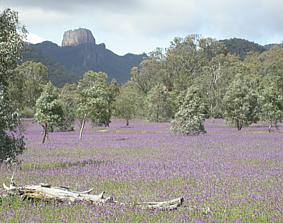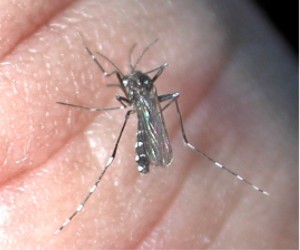Invasive species
|
|

A species is regarded as invasive if it has been introduced by human action to a location, area, or region where it did not previously occur naturally (i.e., is not native), becomes capable of establishing a breeding population in the new location without further intervention by humans, and becomes a pest in the new location, threatening the local biodiversity.
The term invasive species refers to a subset of those species defined as introduced species.
| Contents |
Introduction
Although an invasive species is often defined as an introduced species that has become a pest, some species native to a particular area can, under the influence of human modifications to the environment, increase in numbers and become invasive pests. The Pied Currawong of south-east Australia is an example: as a result of human changes to the landscape, Pied Currawongs increased greatly in range during the 20th century and have caused substantial declines in the populations of the smaller birds whose nestlings they prey on. A species of wetland plant known as 'ae'ae in Hawai'i (the indigenous Bacopa monieri) is regarded as a pest species in artificially manipulated waterbird refuges because it quickly covers shallow mudflats established for endangered Hawaiian stilt (Himantopus mexicanus knudseni), making these undesirable feeding areas for the bird.
Of course all species on earth go through periods of increasing and decreasing population numbers, in many cases accompanied by expansion and contraction of range. A wide variety of circumstances are the cause of such changes, and human "alterations" on the landscape are especially significant in this regard. Anthropogenic (human derived) alteration of an environment that enables expansion of a species into a geographical area where it had not been seen before could be described as invasive because the range expansion results in the species occurring where it was not before native. In essence, one must define "native" with care, as it refers to some natural geographic range of a species, and is not coincident with human political boundaries. Whether noticed increases in population numbers is sufficient reason to regard a native species as "invasive" requires a broad definition of the term—but it seems reasonable to consider that some native species in disrupted ecosystems can become "pests" and in that sense, invasive.
U.S. Executive Order 13112 (1999) defines "invasive species" as "an alien species whose introduction does or is likely to cause economic or environmental harm or harm to human health" (CEQ, 1999). Thus, the term is used to imply a sense of actual or potential harm, something that may not be true for all introduced species.
Historical perspective
Accounts
Although it is assumed that invasive species have been a problem since man has been around to carry them, modern invasive species science began with the work of Charles Elton called The Ecology of Invasions by Animals and Plants, which was first published in 1958. The next ground-breaking work dealing with the principles of invasions was Island Biogeography and Conservation Practice by Simberloff and Abele in 1976.
There are several classic accounts of introduced species that have been causing problems for many decades. The sea lamprey began to make its way up into the Great Lakes of North America when the St. Lawrence Seaway was completed in 1959, devastating the lake trout fishing industry. It continues to be a largely-controlled problem today, but costs millions in lamprecides, traps, physical barriers, and other control methods. More recently, zebra mussels have been accidentally introduced into the Great Lakes (probably in 1988), and have since caused significant alteration to the underwater environment.
Rabbits were introduced into Australia with colonists in the 1800s and their devastation is ongoing in spite of the famous rabbit fences that were built along thousands of miles of territory with the futile intention of keeping them out. See Rabbits in Australia.
Biological control

introduced to the USA, here biting a human.
The often unsuccessful use of biological control provides another historical perspective of the introduced species problem. When rats overwhelmed seaports and became crop pests during the 1800s in some islands in the Pacific, mongoose were introduced to control them. The mongoose preferred to eat native species that were easier to catch than the invasive rats, and became invaders themselves.
Another early use of biological control of an invasive species was an astounding success. In 1868 cottony cushion scale (Icerya purchasi) was accidentally introduced to California in a shipment of nursery plants from Australia. The scale moved into citrus groves and became a major pest, actually killing trees. Since the scale is not a serious pest in Australia, a search began to discover why. In 1888 a naturalist observed Australian ladybirds (Rodolia cardinalis) eating the scale. American lady bugs had shown little interest in the insect. The Australian species was introduced to California, and within a year, the pest was controlled to economically insignificant levels.
Modern day biological control is used only if extensive studies find that the biocontrol species will not have a negative effect on native populations.
See also
Further reading
- Alan Burdick, Out of Eden: An Odyssey of Ecological Invasion, Farrar Straus and Giroux (18 May, 2005), hardcover, 336 pages, ISBN 0374219737
References and external links
- USDA NRCS Plant Materials Program (http://plant-materials.nrcs.usda.gov/)
- Invasivespecies.gov (http://www.invasivespecies.gov/)
- Invasive Species Weblog (http://invasivespecies.blogspot.com/)
- http://www.issg.org/ - Invasive Species Specialist Group
- CEQ (1999). Web site page with Executive Order 13112 (http://ceq.eh.doe.gov/nepa/regs/eos/eo13112.html) text.
- U.S. Government (National Agricultural Library) website on invasive species (http://www.invasivespecies.gov/).
- "The Ecology of Invasions by Animals and Plants" (http://www.press.uchicago.edu/cgi-bin/hfs.cgi/00/14047.ctl)
- Natives Vs. Exotics, The Myth of the Menace, by David I. Theodoropoulos (http://dtheo.org/NativesVs.Exotics.htm)fr:Espèce invasive
